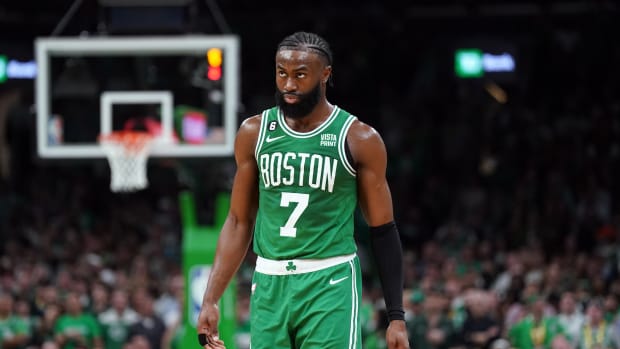
The Clippers and Superstar have joined the list of NBA Big Fours.

The Los Angeles Clippers’ recent signing of James Harden adds to the NBA’s long history of “Big Four” alliances.
Harden formed a superstar quintet with Kawhi Leonard, Paul George, and Russell Westbrook. So far, the move hasn’t benefited LA; the Clippers have yet to win a game, while the Philadelphia 76ers have gone 6-1 since Harden’s departure.
The Lakers’ move to acquire the former MVP came months after the Boston Celtics established their own Big Four. During the offseason, Boston made separate trades for Kristaps Porzingis and Jrue Holiday, combining them alongside Jayson Tatum and Jaylen Brown. The Celtics lead the Eastern Conference with a 9-2 record thanks to the new alliance, which includes crucial players Al Horford and Derrick White.
According to history, the Clippers and Celtics’ Big Four can either win a championship or fail to do so.
Here are some significant NBA Big Four partnerships that were formed through free agency or trades.
When the Phoenix Suns moved Gail Goodrich back to the Los Angeles Lakers in 1970, one of the NBA’s first superteams was formed. Goodrich was drafted by the Lakers but signed with the Suns the next season, the same year Wilt Chamberlain came in Los Angeles.
The group’s first season together ended in a loss in the Western Conference finals, but everything changed the next season.
In 1971-72, the Lakers won 69 games, including an NBA record 33 in a row. Baylor announced its retirement nine games into the season, therefore terminating the Big Four after two seasons. Nonetheless, Los Angeles won the championship, defeating the New York Knicks 4-1 in the 1972 Finals.
Throughout the 1980s, the Lakers had many variations of their own Big Four, much like the Celtics.
Los Angeles acquired Kareem Abdul-Jabbar in a trade in 1975, then signed Jamaal Wilkes in 1977, the same year they drafted Norm Nixon. When the Lakers drafted Magic Johnson in 1979, the trio became a Big Four after trading Gail Goodrich to the then-New Orleans Jazz in 1976.
Johnson, Abdul-Jabbar, Nixon, and Wilkes won championships in 1980 and 1982, with each player averaging at least 15 points per game during the regular season. Los Angeles returned to the Finals in 1983, but were swept by the Philadelphia 76ers.
Due to a previous trade with the Cleveland Cavaliers, the Lakers received the Cavaliers’ No. 1 pick in the 1983 draft, which they used to choose James Worthy. When Nixon was moved in the offseason, Worthy became a new member of the Big Four. The Lakers made the finals in their first season together, but were defeated by the Celtics.
Wilkes’ output dropped in his final season with the Lakers, 1984-85. However, Byron Scott, who was acquired in the Nixon deal, stepped up, averaging 16.9 points per game during Los Angeles’ championship run. Johnson, Abdul-Jabbar, Worthy, and Scott advanced to the NBA Finals four of the next five years, losing only once.
In 1989, Abdul-Jabbar retired, bringing the fruitful collaboration to an end.

Soon after their 1960s domination, the Celtics assembled a Big Four that competed consistently in the 1980s. Boston won the NBA Finals in 1981, but did not return the next two seasons, pushing Red Auerbach to seek a change.
Auerbach acquired Johnson, a four-time All-Star coming off a season in which he averaged 19.5 points per game. The investment immediately paid off. Johnson led the Celtics to the Finals in each of his first four seasons with the organization, earning titles in 1984 and 1986. The 1986 Boston team is widely regarded as one of the best in NBA history.
The Celtics’ success came to an end when they were defeated in the 1987 NBA Finals by the Lakers. After reaching the Eastern Conference finals in 1988, Boston was eliminated in the first round the following two seasons. Johnson stepped down in 1990, Bird in 1992, and McHale in 1993. Parish left the Celtics in 1994, effectively destroying any last traces of a dominating 1980s squad.
After failing to complete a four-peat the previous season, the Los Angeles Lakers signed Hall of Famers Karl Malone and Gary Payton to replace Shaq and Kobe. Both players were nearing the end of their careers and aiming for their first NBA title.
/cdn.vox-cdn.com/uploads/chorus_image/image/72797567/1757110124.0.jpg)
Instead, the teammates started on a season riddled with internal strife as Bryant and O’Neal’s feud reached a fever pitch. For the fourth time in five seasons, the Lakers won 56 games and advanced to the NBA Finals.
The Lakers were considered the favorites to defeat the Detroit Pistons in the Finals. They dropped three games by double digits, including the series-clinching Game 5, which Detroit won 4-1. Malone only played in one Finals game due to an injury.
After the offseason, only Bryant remained with the Lakers; O’Neal and Payton were traded to the Miami Heat, and Malone and coach Phil Jackson retired.
When James and Bosh joined Wade in Miami during the 2010 offseason, they became the NBA’s newest big three. Allen joined with the Heat two years later after spending five seasons with the Boston Celtics, who played Miami in two consecutive playoff trips.
Allen’s decision paid off handsomely for the sharpshooter. In a new role off the bench, he complemented the big three, particularly during the Heat’s championship run in 2012-13.
Allen scored the game-tying jumper with five seconds left in Game 6 of the 2013 NBA Finals against the San Antonio Spurs. Miami eventually won the series in seven games.
The Heat’s fire was extinguished the following season. They advanced to the NBA Finals, but were defeated in five games by the San Antonio Spurs. Soon after, Miami’s collaboration ended when James signed with the Cleveland Cavaliers and Allen retired after an 18-year career. Wade and Bosh stayed in Miami for another two seasons.
Leave a Reply